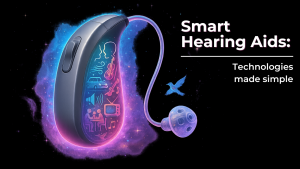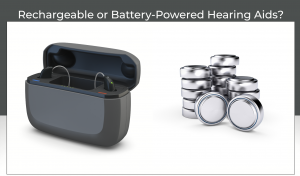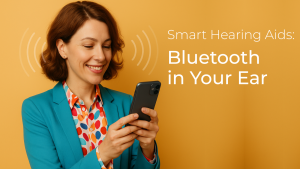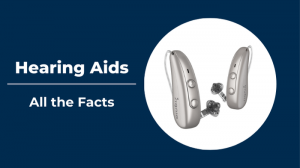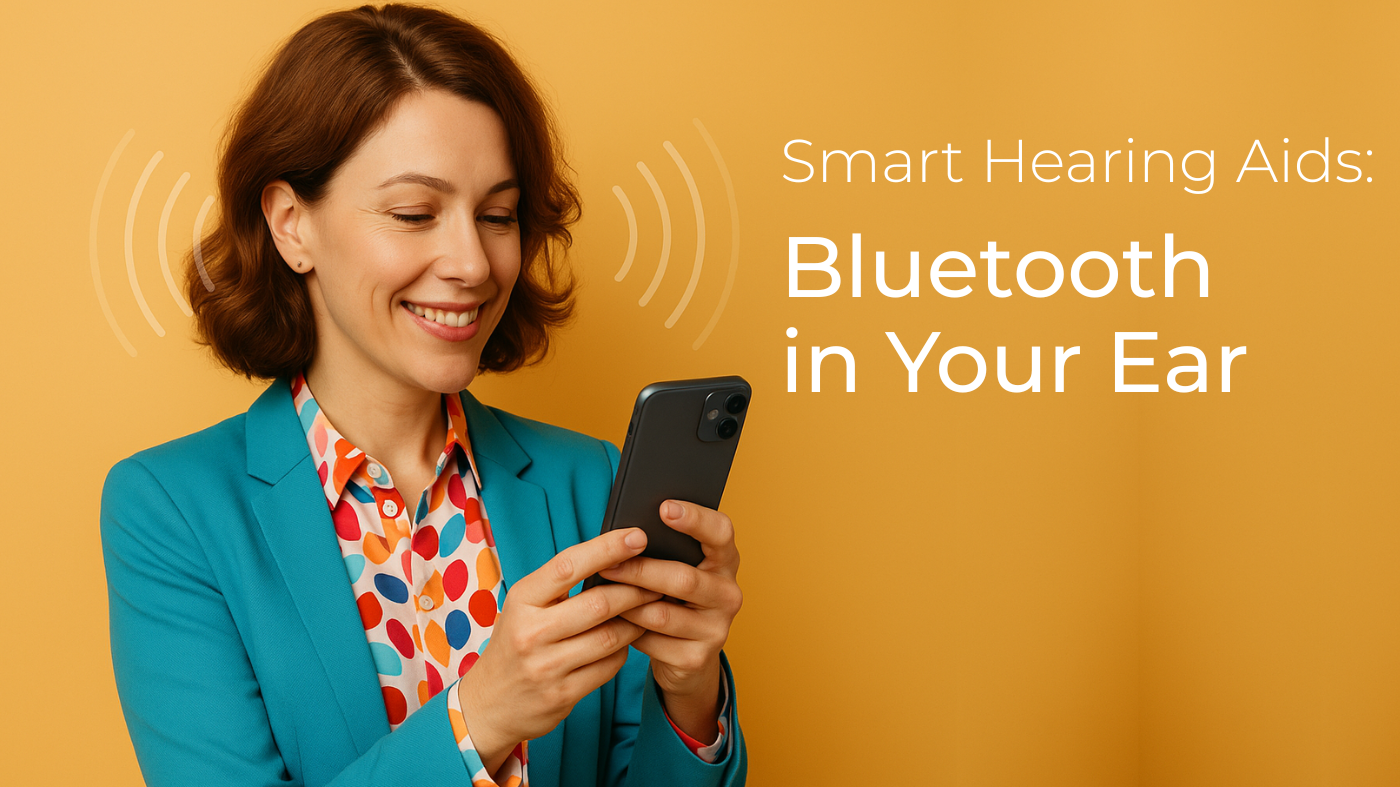
Bluetooth Hearing Aids 2025: How Smart Hearing Aids Enhance Your Listening Experience
Hearing aids are no longer just simple amplifiers. Thanks to modern Bluetooth technology, they’ve become high-tech marvels that go far beyond helping you understand speech. These devices don’t just improve your hearing—they enhance it in fascinating ways. In this post, we’ll explore the world of Bluetooth hearing aids and show you what this smart technology can really do.
Table of contents
1. More Than Just Hearing: What Bluetooth Hearing Aids Can Do
Imagine your hearing aids doubling as a personal sound system, a hands-free device, or even a smart assistant. That’s exactly what Bluetooth hearing aids make possible. Here are some of their most exciting features:
1.1 Direct Connection to Your Smartphone
This is one of the most commonly used features. You can stream phone calls directly into your Bluetooth hearing aids, enjoy music and podcasts in stereo quality, and even hear navigation instructions or voice messages—all through your hearing aids. Everything is controlled conveniently via your smartphone’s standard settings. On top of that, most hearing aid brands offer their own apps. You can adjust the volume, switch listening programs, change the sound profile, or check the battery level—all with just a few taps. Some Bluetooth hearing aids even track health data or translate languages. These extras can also be managed through the app.
1.2 TV Adapters for Crystal-Clear Sound
Do you need to turn the TV up so loud that it bothers others? Or do you struggle to catch every word of dialogue? A Bluetooth TV adapter can solve that. This small transmitter connects to your TV and streams the audio directly to your Bluetooth hearing aids without any loss in quality. The result: a personalized listening experience at the right volume, in brilliant clarity, and without disturbing those around you.

Typically, your hearing aid microphones remain active, so you can still chat with family while watching. But if you want to focus fully on the movie, the app lets you mute the microphones.
1.3 Remote Microphones for Challenging Listening Environments
Restaurants, large meetings, or noisy family gatherings can be tricky for hearing aid users. That’s where remote microphones come in. These small, discreet devices can be placed on a table or clipped to a speaker’s clothing and transmit their voice directly into your hearing aids. Background noise is minimized so you can focus on what matters—conversation. This makes it much easier to stay engaged in social settings.

Remote mics are also great for covering distances. If a speaker is far away, like during a guided tour, they can clip on the mic and you’ll hear them as if they were standing right next to you.
1.4 Connect to Other Audio Devices
Many Bluetooth hearing aids can also pair with other Bluetooth-enabled devices like tablets, laptops, or radios. This dramatically expands their functionality and turns your hearing aids into a versatile everyday companion.
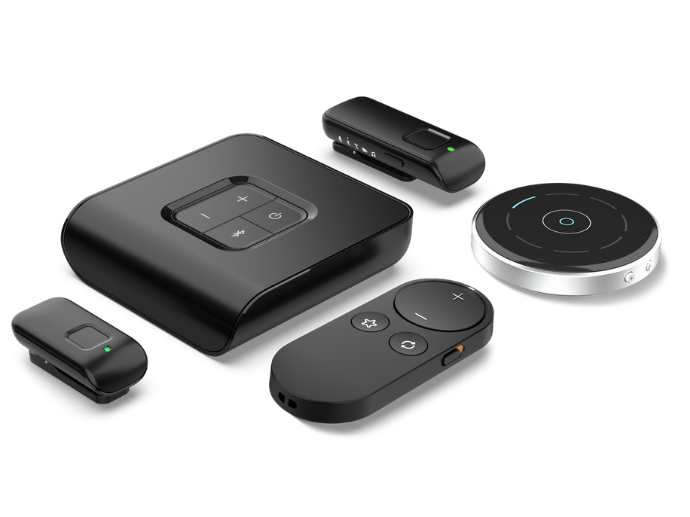
Check out the types of Bluetooth hearing aids available in 2025.
2. Behind the Scenes: The Different Types of Bluetooth in Hearing Aids
To understand how such a wide range of features is possible, it’s worth taking a closer look at the different Bluetooth technologies used in hearing aids:
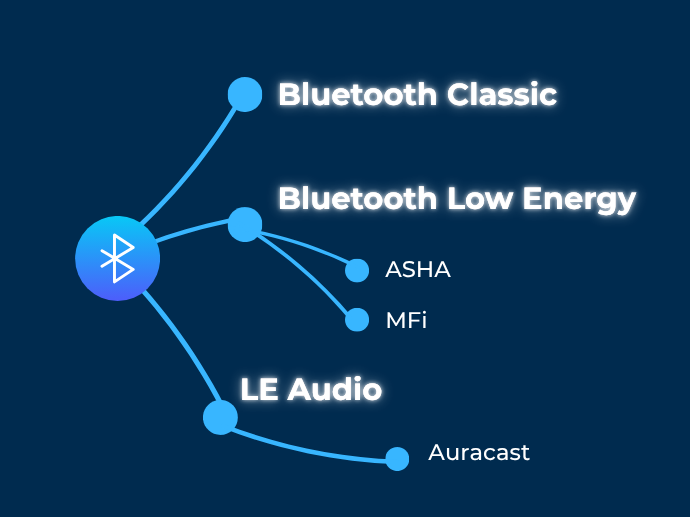
2.1 Bluetooth Classic (BR/EDR)
Description: This is the „traditional“ Bluetooth technology, commonly used in headphones, car kits, and many other devices. It’s known for transferring larger amounts of data and delivering stable, high-quality audio.
Pros: High audio quality, good range, widely used, and compatible with most smartphones. Often supports direct, two-way communication like phone calls.
Cons: Higher power consumption, which can reduce battery life in hearing aids. This has long been the main reason why Bluetooth Classic hasn’t been widely adopted in hearing aids. Even today, only a few manufacturers use it.
Use cases: Direct audio streaming from smartphones. Also works with older mobile phones (non-smartphones) and some landline phones that support Bluetooth.
2.2 Bluetooth Low Energy (BLE or Bluetooth LE)
Description: BLE is designed for applications that prioritize low power consumption over data rate. It’s ideal for devices that only exchange small amounts of data occasionally or stay connected over long periods without draining the battery.
Pros: Extremely low power usage, which significantly extends the battery life of hearing aids.
Cons: Lower bandwidth than Bluetooth Classic, so it’s not ideal for high-quality real-time audio streaming. Mainly used for hearing aid control (via app), switching programs, or streaming low-bandwidth signals.
Use cases: App-based hearing aid control, connections to remote mics or TV streamers (which convert audio into an efficient format), and future LE Audio applications.
2.3 ASHA (Audio Streaming for Hearing Aids)
Description: ASHA is a protocol developed by Google based on BLE, specifically designed for streaming audio from Android devices to hearing aids. It enables direct audio connections between Android phones and compatible hearing aids.
Pros: Energy-efficient audio streaming for Android users, offering good battery life. A major step in giving Android users direct streaming features comparable to what iPhone users enjoy.
Cons: Compatibility depends on the specific Android model and version. Not all Android devices support ASHA yet, though support is increasing.
Use cases: Streaming calls, music, podcasts, and other audio from compatible Android smartphones directly into hearing aids.
2.4 Made for iPhone (MFi) – Apple’s Standard
Description: Apple developed its own specification for hearing aids called „Made for iPhone“ (MFi). These hearing aids use a custom version of BLE to communicate directly with iPhones, iPads, and iPod Touch devices.
Pros: Allows direct audio streaming and full control of the hearing aids through iOS devices without any adapters. MFi hearing aids can also be used for hands-free calls: the iPhone’s microphone captures your voice while the caller’s voice streams directly into your hearing aids. The integration is usually seamless and user-friendly.
Cons: This is Apple’s proprietary standard and only works with Apple products. Though based on BLE, it’s not compatible with the broader LE Audio standard due to Apple’s own protocols.
Use cases: Direct streaming of calls, music, Siri, and app sounds from Apple devices to hearing aids. Hearing aid control via the iPhone.
2.5 Bluetooth LE Audio
Description: The newest generation of Bluetooth Low Energy technology, developed specifically for audio applications. LE Audio overcomes traditional BLE’s limitations for streaming and delivers great sound quality with minimal power use.
Pros: Excellent audio quality with very low power consumption. Supports multiple device connections (like both hearing aids at once) and improved two-way communication. Promises future universal compatibility between Android phones and hearing aids.
Cons: Still not widely available in hearing aids and smartphones, as it’s a relatively new technology. However, adoption is growing fast.
Use cases: Future-proof universal audio streaming from Android phones, improved call and video chat performance via hearing aids.
2.6 Auracast (Part of Bluetooth LE Audio)
Description: Auracast is a groundbreaking feature of Bluetooth LE Audio. It allows a single audio stream to be broadcast to an unlimited number of Auracast-enabled receivers—think of it as a universal Bluetooth audio broadcast system.
Pros: Revolutionizes public audio for both hearing aid users and non-users. Enables personalized, clear sound in challenging environments.
Cons: Still very new, and the infrastructure is just beginning to be built. It will take time before Auracast becomes widespread.

Future use cases include:
- Airports and train stations: Stream clear announcements directly into hearing aids without background noise.
- Cinemas and theaters: Get audio in multiple languages or with special hearing assistance (e.g., audio description) without using headphones.
- Museums and exhibitions: Receive audio guides or exhibit commentary directly in your ears.
- Conference rooms and lecture halls: Hear speakers clearly, even in large or acoustically poor spaces.
- Gyms and sports venues: Stream TV or live commentary audio straight to your hearing aids.
- Restaurants and bars: Listen to background music or sports broadcasts without raising the volume for everyone.
- At home: Families can share TV sound through Auracast, allowing each person to set their own volume—or enjoy music together wirelessly.
If you’re curious about the technical details, the developers behind Bluetooth offer a wealth of information on their official website.
Smarter Hearing Starts Here: Final Thoughts
Bluetooth has fundamentally transformed the world of hearing aids, turning them into intelligent everyday companions. Whether you want to hear conversations more clearly, enjoy your favorite podcast, or watch TV without hassle—the possibilities are vast. And with the rise of Bluetooth LE Audio and the groundbreaking Auracast technology, we’re entering a new era of hearing where clear, personalized sound is possible in almost any environment.
If you’re considering new hearing aids or want to expand the features of your current ones, be sure to talk to your hearing care professional. They can guide you through the different Bluetooth technologies and accessories that best suit your individual needs.
The future of hearing is wireless, smart, and full of new opportunities. Discover for yourself how Bluetooth can revolutionize your listening experience!
About the author
More articles on hearing aid technology you might find interesting
- Smart Hearing Aids: The Technologies That Define Modern Devices in 2025

- Rechargeable vs Battery Hearing Aids: 6 Key Factors to Help You Decide

- Bluetooth Hearing Aids 2025: How Smart Hearing Aids Enhance Your Listening Experience

- Bluetooth Hearing Aids: What’s New in 2025

- Hearing Aids 2025: Everything You Need to Know

- Starkey Edge AI Hearing Aids – Innovative, Powerful, and Energy-Efficient in 2024

Bildquelle: Gerd Altmann auf Pixabay


